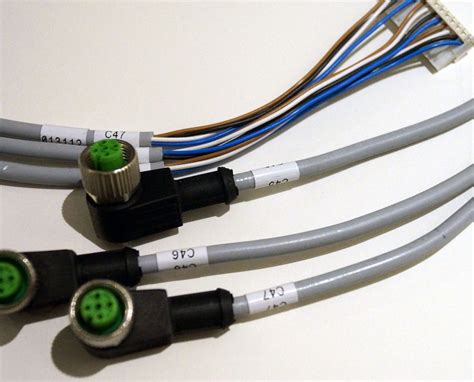What is a Custom Cable Assembly?
A custom cable assembly, also known as a CableAssembly, is a specialized electrical component designed and manufactured to meet specific requirements for a particular application or device. These assemblies consist of various cables, connectors, and other components that are carefully chosen and configured to provide optimal performance, reliability, and compatibility.
Custom cable assemblies are essential in many industries, including:
- Telecommunications
- Automotive
- Aerospace
- Medical devices
- Industrial automation
- Consumer electronics
These tailored solutions offer several advantages over off-the-shelf cable assemblies, as they are engineered to address unique challenges and meet stringent quality standards.
Benefits of Custom Cable Assemblies
-
Enhanced Performance: Custom cable assemblies are designed to optimize signal transmission, minimize interference, and withstand harsh environmental conditions, ensuring superior performance compared to generic cable assemblies.
-
Improved Reliability: By using high-quality materials and adhering to strict manufacturing processes, custom cable assemblies offer increased durability and reliability, reducing the risk of failure and downtime.
-
Space Optimization: Custom cable assemblies can be designed to fit within tight spaces and conform to specific form factors, allowing for more efficient use of space within a device or system.
-
Cost Savings: Although custom cable assemblies may have a higher upfront cost, they can lead to long-term cost savings by reducing maintenance requirements, minimizing downtime, and extending the lifespan of the connected devices.
-
Simplified Installation: Custom cable assemblies are often pre-terminated and tested, simplifying the installation process and reducing the likelihood of errors during deployment.
Types of Custom Cable Assemblies
There are several types of custom cable assemblies, each designed to address specific requirements and applications. Some common types include:
1. Wire Harnesses
A wire harness is a bundled set of wires, cables, and connectors that are pre-assembled and designed to transmit electrical power or signals within a device or system. Wire harnesses are commonly used in automotive, aerospace, and industrial applications, where they help to organize and protect electrical connections.
2. Coaxial Cable Assemblies
Coaxial cable assemblies are designed to transmit high-frequency signals with minimal loss and interference. These assemblies consist of a central conductor surrounded by an insulating layer, a conductive shield, and an outer jacket. Coaxial cable assemblies are commonly used in telecommunications, broadcasting, and networking applications.
3. Ribbon Cable Assemblies
Ribbon cable assemblies are flat, multi-conductor cables that are used to transmit signals between various components within a device. These assemblies are often used in computer systems, electronic equipment, and telecommunications applications, where they offer a compact and organized solution for connecting multiple components.
4. Fiber Optic Cable Assemblies
Fiber optic cable assemblies are designed to transmit data using light pulses through thin strands of glass or plastic. These assemblies offer high bandwidth, low signal loss, and immunity to electromagnetic interference, making them ideal for telecommunications, networking, and medical applications.
5. Power Cable Assemblies
Power cable assemblies are designed to transmit electrical power between components or devices. These assemblies are often custom-designed to meet specific voltage, current, and environmental requirements, ensuring safe and reliable power transmission.
Custom Cable Assembly Design Considerations
When designing a custom cable assembly, several factors must be taken into account to ensure optimal performance, reliability, and compatibility. Some key considerations include:
1. Application Requirements
The specific requirements of the intended application should be the primary driver for the design of a custom cable assembly. Factors such as the operating environment, required bandwidth, signal integrity, and power transmission needs must be carefully considered.
2. Material Selection
Choosing the appropriate materials for the conductors, insulators, and jackets is crucial for ensuring the performance and longevity of a custom cable assembly. Materials must be selected based on their electrical properties, temperature ratings, flexibility, and resistance to environmental factors such as moisture, chemicals, and abrasion.
3. Connector Selection
Selecting the appropriate connectors is essential for ensuring reliable and secure connections between components. Factors such as the number of contacts, pin configuration, locking mechanisms, and environmental resistance must be considered when choosing connectors for a custom cable assembly.
4. Shielding and Grounding
Proper shielding and grounding techniques are essential for minimizing electromagnetic interference (EMI) and ensuring signal integrity. The choice of shielding materials, such as foil, braid, or a combination of both, depends on the specific application and the level of protection required.
5. Regulatory Compliance
Custom cable assemblies must often comply with various industry standards and regulations, such as UL, CSA, and RoHS. Ensuring compliance with these standards is essential for guaranteeing the safety, reliability, and environmental sustainability of the final product.

Manufacturing Process for Custom Cable Assemblies
The manufacturing process for custom cable assemblies involves several steps to ensure the highest quality and reliability. These steps include:
-
Design and Engineering: The first step in the manufacturing process is to create a detailed design and engineering plan based on the specific requirements of the application. This plan includes the selection of materials, connectors, and other components, as well as the creation of detailed drawings and specifications.
-
Cable Cutting and Stripping: The selected cables are cut to the required lengths and stripped to expose the conductors for termination. Automated machines are often used to ensure precise and consistent cutting and stripping.
-
Connector Termination: The exposed conductors are then terminated to the selected connectors using various methods, such as soldering, crimping, or insulation displacement. The choice of termination method depends on the specific requirements of the application and the type of connector used.
-
Assembly and Bundling: The terminated cables and connectors are then assembled and bundled according to the design specifications. This may involve the use of cable ties, heat-shrink tubing, or other methods to ensure a secure and organized assembly.
-
Testing and Quality Control: Once the custom cable assembly is complete, it undergoes rigorous testing and quality control procedures to ensure that it meets the required specifications and performance standards. This may include continuity testing, insulation resistance testing, and environmental stress testing.
-
Packaging and Shipping: Finally, the custom cable assembly is packaged and shipped to the customer. Packaging materials are chosen to protect the assembly during transit and ensure that it arrives in perfect condition.
Applications of Custom Cable Assemblies
Custom cable assemblies are used in a wide range of industries and applications, each with its own unique requirements and challenges. Some common applications include:
1. Automotive Industry
In the automotive industry, custom cable assemblies are used to connect various electronic components, such as sensors, actuators, and control modules. These assemblies must be designed to withstand harsh environmental conditions, including extreme temperatures, vibration, and exposure to chemicals and moisture.
2. Aerospace Industry
Custom cable assemblies are critical components in the aerospace industry, where they are used to transmit power and data between various systems and components. These assemblies must be designed to meet strict weight and space requirements, as well as withstand extreme temperature fluctuations and vibration.
3. Medical Devices
In the medical device industry, custom cable assemblies are used to connect sensors, monitors, and other equipment. These assemblies must be designed to meet stringent safety and reliability standards, as well as be compatible with various sterilization methods.
4. Industrial Automation
Custom cable assemblies are essential components in industrial automation systems, where they are used to connect sensors, actuators, and control devices. These assemblies must be designed to withstand harsh industrial environments, including exposure to chemicals, moisture, and extreme temperatures.
5. Telecommunications
In the telecommunications industry, custom cable assemblies are used to transmit high-frequency signals between various components, such as antennas, base stations, and networking equipment. These assemblies must be designed to minimize signal loss and interference, ensuring reliable and efficient data transmission.
Advantages of Outsourcing Custom Cable Assembly Manufacturing
Outsourcing the manufacturing of custom cable assemblies to a specialized provider offers several advantages, including:
-
Expertise and Experience: Custom Cable Assembly Manufacturers have the expertise and experience necessary to design and produce high-quality assemblies that meet specific requirements and standards.
-
Cost Savings: Outsourcing can help to reduce costs associated with in-house manufacturing, such as equipment investments, labor costs, and inventory management.
-
Scalability: Custom cable assembly manufacturers can easily scale production up or down to meet changing demand, allowing companies to maintain flexibility and responsiveness.
-
Quality Assurance: Specialized manufacturers employ strict quality control processes and testing procedures to ensure that custom cable assemblies meet the highest standards of performance and reliability.
-
Focus on Core Competencies: By outsourcing custom cable assembly manufacturing, companies can focus on their core competencies and allocate resources to other critical areas of their business.
Challenges and Solutions in Custom Cable Assembly Design and Manufacturing
Despite the many benefits of custom cable assemblies, there are also several challenges that must be addressed to ensure optimal performance and reliability. Some common challenges and their solutions include:
1. Electromagnetic Interference (EMI)
EMI can cause signal degradation and compromise the performance of electronic systems. To mitigate EMI, custom cable assemblies can be designed with appropriate shielding and grounding techniques, such as the use of foil or braid shielding, as well as proper connector selection and termination methods.
2. Environmental Factors
Custom cable assemblies must often operate in harsh environmental conditions, such as extreme temperatures, moisture, and chemical exposure. To address these challenges, designers can select materials and components that are rated for the specific environmental conditions, as well as employ protective measures such as jacketing, sealing, and strain relief.
3. Space Constraints
In many applications, custom cable assemblies must fit within tight spaces and conform to specific form factors. To overcome space constraints, designers can use compact connectors, thin-wall insulation, and flexible cable materials, as well as employ 3D modeling and prototyping techniques to optimize the assembly design.
4. Regulatory Compliance
Custom cable assemblies must often comply with various industry standards and regulations to ensure safety, reliability, and environmental sustainability. To meet these requirements, manufacturers can work closely with customers to understand the specific compliance needs and design the assembly accordingly, as well as maintain up-to-date knowledge of relevant standards and regulations.
5. Supply Chain Management
Ensuring a stable and reliable supply of materials and components is essential for the timely and cost-effective production of custom cable assemblies. To mitigate supply chain risks, manufacturers can develop strong relationships with suppliers, maintain adequate inventory levels, and employ robust quality control processes to ensure the consistency and reliability of incoming materials.
Future Trends in Custom Cable Assembly Design and Manufacturing
As technology continues to advance and new applications emerge, custom cable assembly design and manufacturing must adapt to keep pace. Some key trends shaping the future of the industry include:
-
Miniaturization: The increasing demand for smaller and more compact electronic devices is driving the need for miniaturized custom cable assemblies. This trend requires the use of smaller connectors, thinner cables, and advanced manufacturing techniques to produce assemblies that can fit within tight spaces.
-
High-Speed Data Transmission: The growing need for faster data transmission rates is driving the development of custom cable assemblies that can support high-speed protocols, such as USB 3.1, HDMI 2.1, and Thunderbolt 4. These assemblies must be designed to minimize signal loss and interference, ensuring reliable and efficient data transmission.
-
Wireless Connectivity: The proliferation of wireless technologies, such as Wi-Fi, Bluetooth, and 5G, is changing the landscape of custom cable assembly design. While wireless connectivity is becoming more prevalent, custom cable assemblies remain essential for providing power and ensuring reliable data transmission in many applications.
-
Sustainability: The increasing focus on environmental sustainability is driving the development of eco-friendly materials and manufacturing processes for custom cable assemblies. This includes the use of halogen-free and recyclable materials, as well as the adoption of energy-efficient manufacturing techniques.
-
Industry 4.0: The rise of Industry 4.0 technologies, such as the Internet of Things (IoT), artificial intelligence (AI), and robotics, is transforming the manufacturing landscape. Custom cable assembly manufacturers are leveraging these technologies to improve efficiency, quality, and flexibility, enabling them to meet the evolving needs of their customers.
Frequently Asked Questions (FAQ)
1. What is the difference between a custom cable assembly and an off-the-shelf cable?
A custom cable assembly is designed and manufactured to meet specific requirements for a particular application or device, while an off-the-shelf cable is a pre-made, standard cable that is readily available for purchase. Custom cable assemblies offer enhanced performance, reliability, and compatibility compared to off-the-shelf cables.
2. How long does it take to design and manufacture a custom cable assembly?
The lead time for designing and manufacturing a custom cable assembly varies depending on the complexity of the design, the availability of materials and components, and the manufacturing capacity of the provider. In general, the process can take anywhere from a few weeks to several months.
3. How much does a custom cable assembly cost?
The cost of a custom cable assembly depends on several factors, including the complexity of the design, the materials and components used, and the quantity ordered. In general, custom cable assemblies have a higher upfront cost compared to off-the-shelf cables, but they can offer long-term cost savings by reducing maintenance requirements and extending the lifespan of connected devices.
4. Can custom cable assemblies be designed for harsh environmental conditions?
Yes, custom cable assemblies can be designed to withstand harsh environmental conditions, such as extreme temperatures, moisture, and chemical exposure. This is achieved through the selection of appropriate materials, components, and protective measures, such as jacketing, sealing, and strain relief.
5. What certifications and compliance standards are important for custom cable assemblies?
The certifications and compliance standards that are important for custom cable assemblies vary depending on the specific industry and application. Some common standards include UL, CSA, RoHS, and REACH. It is important to work with a custom cable assembly manufacturer that is knowledgeable about the relevant standards and can ensure compliance with the necessary requirements.
Conclusion
Custom cable assemblies are essential components in a wide range of industries and applications, offering enhanced performance, reliability, and compatibility compared to off-the-shelf cables. By carefully considering the specific requirements of the application and leveraging the expertise of specialized manufacturers, companies can design and produce custom cable assemblies that meet the highest standards of quality and performance.
As technology continues to evolve and new applications emerge, custom cable assembly design and manufacturing must adapt to keep pace. By staying abreast of the latest trends and technologies, such as miniaturization, high-speed data transmission, wireless connectivity, sustainability, and Industry 4.0, manufacturers can continue to provide innovative and reliable solutions that meet the evolving needs of their customers.
| Industry | Application | Key Requirements |
|---|---|---|
| Automotive | Connecting electronic components (sensors, actuators, control modules) | – Resistance to harsh environmental conditions (temperature, vibration, chemicals, moisture) |
| Aerospace | Transmitting power and data between systems and components | – Strict weight and space requirements – Resistance to extreme temperature fluctuations and vibration |
| Medical Devices | Connecting sensors, monitors, and other equipment | – Stringent safety and reliability standards – Compatibility with sterilization methods |
| Industrial Automation | Connecting sensors, actuators, and control devices | – Resistance to harsh industrial environments (chemicals, moisture, extreme temperatures) |
| Telecommunications | Transmitting high-frequency signals between components (antennas, base stations, networking equipment) | – Minimization of signal loss and interference – Reliable and efficient data transmission |
By understanding the unique requirements and challenges of each industry and application, custom cable assembly manufacturers can deliver tailored solutions that optimize performance, reliability, and compatibility, ultimately enabling their customers to achieve success in their respective fields.






Leave a Reply